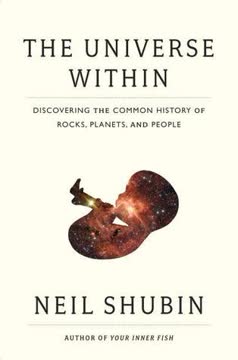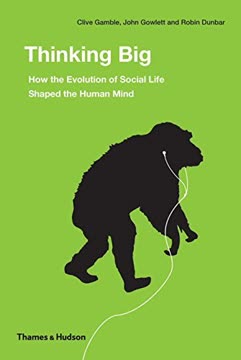Key Takeaways
1. The Social Brain Hypothesis: Evolution of Human Cognition
"We see two main advantages for increasing the size of the community you live in, advantages that outweigh the massive costs of evolving bigger brains to cope with the greater cognitive load of remembering and acting on social information about others. These are security and reassurance."
Social pressures drove brain growth. The social brain hypothesis posits that the primary driver of human brain evolution was the need to manage increasingly complex social relationships. As early hominins formed larger groups for protection and cooperation, they needed greater cognitive capacity to remember, understand, and navigate social dynamics.
Key factors in social brain evolution:
- Predator protection
- Resource sharing
- Cooperative hunting
- Alliance formation
- Conflict resolution
This evolutionary pressure led to the development of advanced social cognition, including theory of mind, empathy, and the ability to understand and manipulate social hierarchies. The increased brain size and cognitive abilities allowed humans to form larger, more complex social groups, which in turn provided evolutionary advantages in survival and reproduction.
2. Dunbar's Number: The Limits of Social Relationships
"The social brain hypothesis predicts that humans have a natural grouping size of around 150. But is this really true?"
150: The magic number of relationships. Dunbar's number, approximately 150, represents the cognitive limit to the number of stable social relationships an individual can maintain. This number appears consistently across various human societies, from hunter-gatherer groups to modern social networks.
Layers of social relationships:
- 5: Closest friends/family
- 15: Good friends
- 50: Friends
- 150: Acquaintances
Despite technological advancements and larger population sizes, humans still naturally organize into groups of about 150 individuals. This limitation is rooted in our cognitive capacity and the time required to maintain meaningful relationships. Even in the digital age, studies show that people typically maintain active connections with 100-250 individuals on social media platforms, aligning with Dunbar's number.
3. The Power of Touch: From Grooming to Language
"Social grooming is one of the contexts in which endorphins are released, and social grooming is, of course, the central mechanism involved in social bonding in monkeys and apes."
From physical to verbal grooming. In primate societies, physical grooming serves as a crucial bonding mechanism, releasing endorphins that reinforce social connections. As human societies grew larger, the time required for physical grooming became unsustainable, leading to the development of alternative bonding mechanisms.
Evolution of social bonding:
- Physical grooming (primates)
- Laughter and music (early humans)
- Language (modern humans)
Language emerged as an efficient way to "groom" multiple individuals simultaneously, allowing humans to maintain larger social networks. This transition from physical to verbal grooming marked a significant step in human evolution, enabling the formation of more complex social structures and the transmission of cultural knowledge.
4. Fire and Cooking: Catalysts for Brain Growth
"Simply put, instead of needing to gain 2000 calories from a 12- to 14-hour day, a human may need 3000 or 4000 from 7 to 8 hours. Humans usually take their meals following preparation, in intensive short periods, often shared – this food-sharing was taken by archaeologist Glynn Isaac to be one of the prime driving forces in human evolution."
Cooking fueled cognitive expansion. The control of fire and the advent of cooking played a crucial role in human brain evolution. Cooked food provided more easily digestible nutrients, allowing for the development of smaller guts and larger brains.
Benefits of cooking:
- Increased nutrient absorption
- Reduced energy expenditure on digestion
- Enabled brain growth
- Extended "social day" around the fire
- Facilitated food sharing and social bonding
The use of fire also extended the "social day," providing a focal point for group gatherings and storytelling. This additional time for social interaction further drove the development of language and complex social cognition.
5. Tools and Technology: Extending the Social Mind
"We are one with our material worlds and the environments we have built to live in – but humans take this much further."
Tools as cognitive extensions. The development of tools and technology played a crucial role in human cognitive evolution. Tools served not just as practical implements but as extensions of human cognition, allowing for the externalization of memory and problem-solving.
Cognitive impacts of tool use:
- Extended memory (e.g., notched bones for counting)
- Enhanced problem-solving capabilities
- Facilitated social learning and cultural transmission
- Enabled more complex social organization
The creation and use of tools required advanced planning, mental simulation, and social learning. This co-evolution of technology and cognition allowed humans to adapt to diverse environments and develop increasingly complex societies.
6. The Rise of Symbolism and Art in Human Evolution
"Art would be our further great aid, but its pattern of preservation is exceedingly patchy. We will come to art, but first we can extract an important idea, that part of art is simply 'making special', and that we can begin to find this making special on a much broader basis."
Symbolism: The cognitive leap. The emergence of symbolic thought and artistic expression marked a significant milestone in human cognitive evolution. Art and symbols allowed for the externalization of abstract concepts and the transmission of complex ideas across time and space.
Forms of early symbolic expression:
- Cave paintings
- Figurines and sculptures
- Personal ornaments (e.g., beads, pendants)
- Burial practices
This capacity for symbolic thought enabled humans to create and maintain shared cultural narratives, religious beliefs, and social identities. The ability to "make special" through art and ritual practices strengthened social bonds and group cohesion, contributing to the success of human societies.
7. Language Evolution: From Laughter to Complex Communication
"We would argue that language grew out of laughter. But at that point, we hit a glass ceiling again. Something else was needed to allow our three large-brained hominins, H. heidelbergensis, Neanderthals and H. sapiens, to lift community size still further."
From laughter to language. The evolution of language was a gradual process, building upon existing social vocalizations like laughter. As social groups grew larger, more sophisticated communication was needed to maintain social bonds and coordinate activities.
Stages of language evolution:
- Non-verbal communication (gestures, facial expressions)
- Simple vocalizations (laughter, calls)
- Proto-language (simple word combinations)
- Full language (complex grammar and syntax)
The development of language allowed for the transmission of complex ideas, the creation of shared cultural knowledge, and the coordination of large-scale social activities. This linguistic capacity, combined with advanced theory of mind, enabled humans to navigate increasingly complex social landscapes.
8. Neanderthals vs. Homo Sapiens: Cognitive Differences
"What we conclude is that large-brained hominins such as H. heidelbergensis and Neanderthals would have been able to manage fourth order intentionality. This would have had a very significant limiting effect on the grammatical complexity of their language – and on the complexity of the stories they could tell."
Subtle cognitive distinctions. While both Neanderthals and Homo sapiens had large brains, subtle differences in cognitive capabilities may have contributed to the eventual success of Homo sapiens.
Cognitive comparison:
- Neanderthals: 4th order intentionality
- Homo sapiens: 5th order intentionality
This difference in intentionality levels suggests that Homo sapiens may have had a slight edge in:
- Language complexity
- Storytelling abilities
- Social coordination
- Abstract thinking
These cognitive differences, while subtle, may have provided Homo sapiens with advantages in adapting to new environments, forming larger social networks, and transmitting cultural knowledge more effectively.
9. The Agricultural Revolution: Reshaping Social Structures
"When population was small and mobile the occurrence of natural disasters such as volcanic eruptions had little impact."
Agriculture: A double-edged sword. The transition to agriculture marked a significant shift in human social organization, allowing for larger, more sedentary populations but also introducing new challenges.
Impacts of the Agricultural Revolution:
- Increased population density
- Development of permanent settlements
- Emergence of social hierarchies
- Specialization of labor
- New forms of social organization (e.g., chiefdoms, states)
While agriculture enabled the growth of larger societies, it also created new vulnerabilities to environmental disasters and social conflicts. The shift to agriculture required humans to adapt their social cognition to manage larger, more complex social structures, leading to the development of new institutions and forms of leadership.
10. Religion, Leadership, and Warfare: Managing Large Societies
"Given the role of organized religion in coercing populations to toe the communal line, the most plausible explanation for the rise of these kinds of religion is the social and psychological stress imposed by large communities."
New tools for social cohesion. As human societies grew larger and more complex, new mechanisms were needed to maintain social cohesion and manage conflicts. Religion, leadership, and warfare emerged as powerful tools for organizing and motivating large groups.
Functions of religion, leadership, and warfare:
- Establish shared beliefs and values
- Create social hierarchies
- Coordinate large-scale activities
- Manage conflicts within and between groups
- Provide explanations for natural phenomena
These cultural innovations allowed humans to overcome the limitations of their evolved social cognition, enabling the formation and maintenance of societies far larger than the 150-individual groups predicted by Dunbar's number.
11. The Digital Age: Amplifying Ancient Social Patterns
"Despite the opportunity to create new connections at the click of a 'friending' button, in fact most people's Facebook pages list only between 100 and 250 names, as one study of 1 million Facebook pages recently revealed."
Old brains, new technology. The digital age has not fundamentally changed human social cognition but has instead amplified existing social patterns and tendencies.
Digital age observations:
- Social media networks align with Dunbar's number
- Face-to-face interactions still preferred for close relationships
- Digital communication enables maintenance of weak ties
- Online communities mirror offline social structures
While digital technology has expanded our ability to connect with others, it has not altered the fundamental constraints of human social cognition. Instead, it has provided new tools for managing and maintaining our social networks within the limits of our evolved capacities.
Human cognition, shaped by millions of years of evolution, continues to influence how we interact and form communities in the modern world. Understanding these deep-rooted social tendencies can help us better navigate the challenges of large-scale societies and harness the potential of new technologies to enhance human cooperation and well-being.
Last updated:
FAQ
What is Thinking Big: How the Evolution of Social Life Shaped the Human Mind by Clive Gamble about?
- Exploration of human evolution: The book investigates how social life, community size, and relationships shaped the evolution of the human brain and mind over millions of years.
- Interdisciplinary approach: It integrates archaeology, psychology, and evolutionary biology to provide a comprehensive understanding of human origins.
- Key themes: Topics include the evolution of the social brain, the development of tools, the control of fire, the emergence of language, and the role of emotions and culture in human evolution.
- Central argument: The authors propose that increasing social complexity, rather than sudden revolutions, drove the gradual development of modern human cognition.
Why should I read Thinking Big by Clive Gamble, John Gowlett, and Robin Dunbar?
- Unique interdisciplinary insight: The book combines expertise from archaeology, anthropology, and evolutionary psychology, offering a holistic view of human evolution.
- Challenges traditional narratives: It moves beyond fossil records to focus on social cognition and gradual change, providing a nuanced perspective on what makes us human.
- Relevance to modern life: The book connects deep evolutionary history to contemporary social behavior, explaining why our brains and social networks function as they do today.
- Practical implications: Readers gain a better understanding of the limits and structure of their own social lives, including the impact of technology and digital networks.
What are the key takeaways from Thinking Big by Clive Gamble?
- Gradual evolution of the mind: Human cognitive and social complexity evolved incrementally over millions of years, not through sudden leaps.
- Social brain as central: The size and structure of the human brain are closely linked to the demands of managing increasingly large and complex social groups.
- Material culture as social amplifier: Tools, language, and rituals served to extend and reinforce social bonds, enabling larger communities and more intricate cooperation.
- Modern mind as adaptation: The human mind is best understood as a set of social skills shaped by evolutionary pressures to manage complex social networks.
What is the social brain hypothesis as explained in Thinking Big by Clive Gamble?
- Brain size and group size: The hypothesis posits a direct correlation between neocortex size and the number of stable social relationships an individual can maintain, known as Dunbar’s number (about 150).
- Cognitive demands of social life: Larger brains evolved to handle the increased complexity of social interactions and relationships in bigger groups.
- Evidence from primates: Studies of monkeys and apes show that species with larger neocortexes maintain larger social groups, a pattern that extends to humans.
- Implications for evolution: The need to manage social relationships was a primary driver of brain enlargement and cognitive sophistication in hominins.
What is Dunbar’s number and why is it significant in Thinking Big by Clive Gamble?
- Definition and origin: Dunbar’s number is the cognitive limit on the number of stable social relationships a human can maintain, estimated at around 150, based on neocortex size.
- Modern relevance: Despite living in large cities, humans typically maintain personal social networks of this size, with layers of intimacy scaling by factors of three.
- Evolutionary puzzle: The book explores how humans evolved to manage larger social groups than other primates and how this limit persists in modern society.
- Supporting evidence: Data from hunter-gatherer societies, personal networks, and even Christmas card lists support the existence of this cognitive constraint.
How does Thinking Big by Clive Gamble explain the evolution of human social cognition and mentalizing?
- Mentalizing defined: Mentalizing, or theory of mind, is the ability to infer others’ thoughts and intentions, enabling complex social interactions like cooperation and deception.
- Orders of intentionality: Humans can handle up to fifth or sixth order intentionality (e.g., "I think that you think that she thinks..."), which is crucial for managing multiple relationships.
- Brain structure link: Brain imaging shows that areas like the orbitofrontal cortex are larger in people with bigger social networks and higher mentalizing abilities.
- Evolutionary significance: The development of advanced mentalizing abilities allowed humans to form and maintain larger, more complex social groups.
What role do emotions, music, and laughter play in human social evolution according to Thinking Big by Clive Gamble?
- Emotions as social glue: Emotions such as guilt, compassion, and pride are essential for maintaining social bonds and regulating group behavior.
- Music and laughter: These activities release endorphins, bonding groups together beyond one-on-one interactions and enabling larger communities.
- Evolutionary function: Emotional closeness and shared experiences foster trust and cooperation, which are vital for the survival of large social groups.
- Beyond grooming: Music and laughter serve as group-level bonding mechanisms, replacing the time-consuming grooming seen in other primates.
How does Thinking Big by Clive Gamble address the evolution of language and its social functions?
- Language as social tool: Language evolved primarily to manage social relationships and facilitate gossip, not just to convey information.
- Gradual development: Anatomical and genetic evidence suggests language capacity developed over hundreds of thousands of years, with early hominins achieving lower orders of intentionality.
- Efficiency over grooming: As group sizes increased, vocal communication became a more efficient way to maintain social bonds than physical grooming.
- Support for complex societies: Language enabled higher orders of mentalizing and the management of larger, more intricate social networks.
What is the concept of the extended mind in Thinking Big by Clive Gamble?
- Beyond the brain: The extended mind includes not only neural processes but also artifacts, environments, and social interactions that shape cognition.
- Distributed cognition: Social cognition is embodied in tools, places, and practices, forming a cognitive niche constructed by humans.
- Material culture’s role: Tools and technology are seen as extensions of the mind, amplifying social signals and enabling cooperation beyond immediate contact.
- Evolutionary advantage: This concept explains how early hominins managed larger social groups and complex behaviors by integrating external resources into their cognitive processes.
How do tools, technology, and material culture relate to the social brain in Thinking Big by Clive Gamble?
- Tools as social products: Toolmaking and use are embedded in social contexts, requiring learning, teaching, and cultural transmission within groups.
- Feedback loop: The appearance of stone tools coincides with increases in brain size and social group size, suggesting a feedback loop between technology and social complexity.
- Amplification of social bonds: Material culture, including ornaments and architecture, serves as external memory and communication tools, reinforcing social ties.
- Gradual amplification: The book argues that technological and cultural complexity increased gradually, building on existing social and cognitive frameworks.
How does Thinking Big by Clive Gamble compare Neanderthals and modern humans in terms of social and cognitive abilities?
- Brain size and structure: Both had large brains, but Neanderthals had larger visual systems, possibly limiting frontal lobe expansion related to social cognition.
- Social group size: Neanderthals likely maintained smaller social groups due to these cognitive constraints, while modern humans managed larger, more complex networks.
- Cultural and symbolic behavior: Neanderthals showed evidence of burial rites and tool use, but their social and linguistic complexity was likely less than that of Homo sapiens.
- Population dispersal: Modern humans developed more complex kinship systems and social networks, enabling global expansion.
What does Thinking Big by Clive Gamble reveal about the transition from small-brained apes to large-brained humans?
- Gradual brain growth: Brain size increased from about 325 cc in early hominins to over 900 cc in early Homo, correlating with larger social group sizes and more complex social lives.
- Social and ecological pressures: Environmental changes, dietary shifts (like increased meat consumption), and social cooperation drove the need for bigger brains.
- Technological and social innovations: The emergence of stone tools, control of fire, and extended social networks both reflected and reinforced brain expansion.
- No single defining moment: The transition to a modern mind was a slow, overlapping process, with no clear-cut fossil or artifact marking its emergence.
Review Summary
Thinking Big receives mixed reviews, with ratings ranging from 2 to 5 stars. Many readers find the book's central thesis on the social brain hypothesis intriguing, though some criticize its speculative nature and lack of concrete evidence. Reviewers appreciate the interdisciplinary approach combining archaeology and psychology but note the writing can be dense and academic. Several highlight the book's exploration of human evolution, social group sizes, and the development of language and culture. Some readers find the content fascinating, while others feel it lacks novelty or convincing arguments.
Similar Books










Download PDF
Download EPUB
.epub digital book format is ideal for reading ebooks on phones, tablets, and e-readers.





